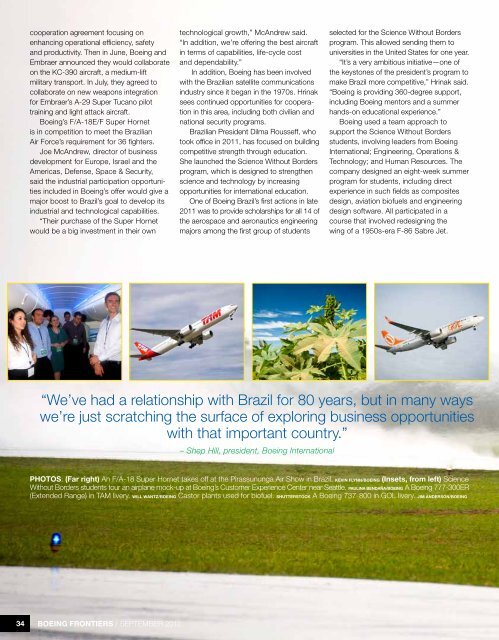Frontiers - Space-Library
Frontiers - Space-Library
Frontiers - Space-Library
Create successful ePaper yourself
Turn your PDF publications into a flip-book with our unique Google optimized e-Paper software.
cooperation agreement focusing on<br />
enhancing operational efficiency, safety<br />
and productivity. Then in June, Boeing and<br />
Embraer announced they would collaborate<br />
on the KC-390 aircraft, a medium-lift<br />
military transport. In July, they agreed to<br />
collaborate on new weapons integration<br />
for Embraer’s A-29 Super Tucano pilot<br />
training and light attack aircraft.<br />
Boeing’s F/A-18E/F Super Hornet<br />
is in competition to meet the Brazilian<br />
Air Force’s requirement for 36 fighters.<br />
Joe McAndrew, director of business<br />
development for Europe, Israel and the<br />
Americas, Defense, <strong>Space</strong> & Security,<br />
said the industrial participation opportunities<br />
included in Boeing’s offer would give a<br />
major boost to Brazil’s goal to develop its<br />
industrial and technological capabilities.<br />
“Their purchase of the Super Hornet<br />
would be a big investment in their own<br />
technological growth,” McAndrew said.<br />
“In addition, we’re offering the best aircraft<br />
in terms of capabilities, life-cycle cost<br />
and dependability.”<br />
In addition, Boeing has been involved<br />
with the Brazilian satellite communications<br />
industry since it began in the 1970s. Hrinak<br />
sees continued opportunities for cooperation<br />
in this area, including both civilian and<br />
national security programs.<br />
Brazilian President Dilma Rousseff, who<br />
took office in 2011, has focused on building<br />
competitive strength through education.<br />
She launched the Science Without Borders<br />
program, which is designed to strengthen<br />
science and technology by increasing<br />
opportunities for international education.<br />
One of Boeing Brazil’s first actions in late<br />
2011 was to provide scholarships for all 14 of<br />
the aerospace and aeronautics engineering<br />
majors among the first group of students<br />
selected for the Science Without Borders<br />
program. This allowed sending them to<br />
universities in the United States for one year.<br />
“It’s a very ambitious initiative—one of<br />
the keystones of the president’s program to<br />
make Brazil more competitive,” Hrinak said.<br />
“Boeing is providing 360-degree support,<br />
including Boeing mentors and a summer<br />
hands-on educational experience.”<br />
Boeing used a team approach to<br />
support the Science Without Borders<br />
students, involving leaders from Boeing<br />
International; Engineering, Operations &<br />
Technology; and Human Resources. The<br />
company designed an eight-week summer<br />
program for students, including direct<br />
experience in such fields as composites<br />
design, aviation biofuels and engineering<br />
design software. All participated in a<br />
course that involved redesigning the<br />
wing of a 1950s-era F-86 Sabre Jet.<br />
“We’ve had a relationship with Brazil for 80 years, but in many ways<br />
we’re just scratching the surface of exploring business opportunities<br />
with that important country.”<br />
– Shep Hill, president, Boeing International<br />
PHOTOS: (Far right) An F/A-18 Super Hornet takes off at the Pirassununga Air Show in Brazil. kevin flynn/boeing (Insets, from left) Science<br />
Without Borders students tour an airplane mock-up at Boeing’s Customer Experience Center near Seattle. Paulina bendaÑa/boeing A Boeing 777-300ER<br />
(Extended Range) in TAM livery. will wantz/boeing Castor plants used for biofuel. shutterstock A Boeing 737-800 in GOL livery. jim anderson/boeing<br />
34 BOEING FRONTIERS / SEPTEMBER 2012
















